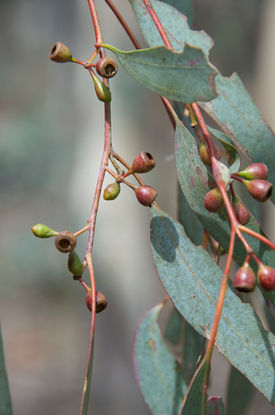
Strategic tree and forest establishment and regeneration on the Southern Tablelands
Eucalyptus melliodora
Yellow Box
MYRTACEAE
Native range: Vic, ACT, NSW, Qld Height: 15-30 m Width: 10-15 m Flowering: Spring Fruiting: Summer to autumn Light: Full sun Growth rate: Moderate to slow Soils: Free-draining loam, clay loam and alluvial soils Drought tolerance: Moderate Landscape position: Lower slopes Rainfall range: 500 – 1000 mm Benefits: Yellow Box (Eucalyptus melliodora) is long-lived, relatively slow growing evergreen native tree that is frequently seen as statuesque remnant mature trees in paddocks and grassy woodlands. It has attractive box bark and spreading open canopy when mature. The bark in juvenile trees has a yellowish tinge, but bark characteristics change throughout the life of Yellow Box trees, with adults often having dark rough, dark brown bark on the trunk and ribbony grey strips in the upper limbs. The sapwood of Yellow Box is bright yellow. Eucalyptus melliodora flowers profusely and produces very high quality honey. It is excellent habitat for wildlife, attracting a wide of range of pollinating insects and birds when in flower. The seed is a food source for parrot species. Mature trees with hollows are nesting sites for birds. This species makes an excellent street tree as it does not drop as much litter as other eucalypt species and provides quite good shade – although canopy density fluctuates with water availability. It a useful species for shelterbelts, providing mid-to-high level protection. Eucalyptus melliodora has hard, durable timber which is coloured from pinkish-yellow to rich brown. It has been used for fencing, poles and sleepers, but is also finding use in craft use, especially the burl wood. Yellow Box is a key species of White Box–Yellow Box–Blakely’s Red Gum grassy woodlands, a critically endangered vegetation type that once covered extensive areas of south-eastern Australia. It grows on good soils on lower slopes, areas that have been historically cleared for grazing and it has excellent, slow-burning timber that is over-harvested for firewood. As a result, natural populations have declined across the landscape and existing populations remain in small remnant stands. The individuals in these stands (and in paddocks) tend to be closely related with low genetic diversity as a result. Drawbacks: Only flowers in alternate years, so interplant with other good honey producing species to ensure flowering resources every year. Too large for domestic gardens. Does not perform well when planted in lawns. Uses: Ornamental and landscaping use in parklands and gardens Shelterbelts Produces excellent honey Habitat for native biodiversity Specialty timber used in cabinetry and fine craft items Timber for firewood Propagation: From seed. Source seed from wide geographic range to repair the population gaps created by land clearing. Focus on including seed from drier regions in western NSW. Weed risk: None Future climate risks: Lack of flowering, canopy thinning and slow growth during extended dry years and heatwaves. Branch dieback, limb drop and death of trees in dry, exposed sites. Increase of disease and insect attack due to uneven climate. References AVH (2022). The Australasian Virtual Herbarium, Council of Heads of Australasian Herbaria –https://avh.chah.org.au Beuhne, F.R., The Honey Flora of Victoria (1922) – PlantNET (The NSW Plant Information Network System). Royal Botanic Gardens and Domain Trust, Sydney – https://shorturl.at/hiDFN TreeProject – https://shorturl.at/vVY59 T.H. Booth, L.M. Broadhurst, E. Pinkard, S.M. Prober, S.K. Dillon, D. Bush, K. Pinyopusarerk, J.C. Doran, M. Ivkovich, A.G. Young, Native forests and climate change: Lessons from eucalypts, Forest Ecology and Management, Vol. 347, 2015. Woolshed Thurgoona Landcare Group website – https://shorturl.at/djx37


























